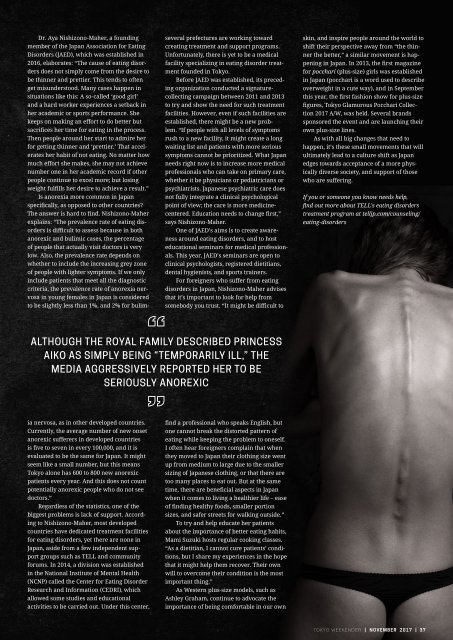Tokyo Weekender - November 2017
Our November issue is out, featuring a jam-packed end-of-year special: 42 Christmas gift shopping ideas and 10 bonenkai spots. Plus: The avant-garde world of butoh dance, Japanese teen prodigies, and a special supplement guide to Akita. Here's where to find a copy around Tokyo: www.tokyoweekender.com/pickup/
Our November issue is out, featuring a jam-packed end-of-year special: 42 Christmas gift shopping ideas and 10 bonenkai spots. Plus: The avant-garde world of butoh dance, Japanese teen prodigies, and a special supplement guide to Akita. Here's where to find a copy around Tokyo: www.tokyoweekender.com/pickup/
You also want an ePaper? Increase the reach of your titles
YUMPU automatically turns print PDFs into web optimized ePapers that Google loves.
several prefectures are working toward<br />
creating treatment and support programs.<br />
Unfortunately, there is yet to be a medical<br />
facility specializing in eating disorder treatment<br />
founded in <strong>Tokyo</strong>.<br />
Before JAED was established, its preceding<br />
organization conducted a signaturecollecting<br />
campaign between 2011 and 2013<br />
to try and show the need for such treatment<br />
facilities. However, even if such facilities are<br />
established, there might be a new problem.<br />
“If people with all levels of symptoms<br />
rush to a new facility, it might create a long<br />
waiting list and patients with more serious<br />
symptoms cannot be prioritized. What Japan<br />
needs right now is to increase more medical<br />
professionals who can take on primary care,<br />
whether it be physicians or pediatricians or<br />
psychiatrists. Japanese psychiatric care does<br />
not fully integrate a clinical psychological<br />
point of view; the care is more medicinecentered.<br />
Education needs to change first,”<br />
says Nishizono-Maher.<br />
One of JAED’s aims is to create awareness<br />
around eating disorders, and to host<br />
educational seminars for medical professionals.<br />
This year, JAED’s seminars are open to<br />
clinical psychologists, registered dietitians,<br />
dental hygienists, and sports trainers.<br />
For foreigners who suffer from eating<br />
disorders in Japan, Nishizono-Maher advises<br />
that it’s important to look for help from<br />
somebody you trust. “It might be difficult to<br />
skin, and inspire people around the world to<br />
shift their perspective away from “the thinner<br />
the better,” a similar movement is happening<br />
in Japan. In 2013, the first magazine<br />
for pocchari (plus-size) girls was established<br />
in Japan (pocchari is a word used to describe<br />
overweight in a cute way), and in September<br />
this year, the first fashion show for plus-size<br />
figures, <strong>Tokyo</strong> Glamorous Pocchari Collection<br />
<strong>2017</strong> A/W, was held. Several brands<br />
sponsored the event and are launching their<br />
own plus-size lines.<br />
As with all big changes that need to<br />
happen, it’s these small movements that will<br />
ultimately lead to a culture shift as Japan<br />
edges towards acceptance of a more physically<br />
diverse society, and support of those<br />
who are suffering.<br />
If you or someone you know needs help,<br />
find out more about TELL's eating disorders<br />
treatment program at telljp.com/counseling/<br />
eating-disorders<br />
ALTHOUGH THE ROYAL FAMILY DESCRIBED PRINCESS<br />
AIKO AS SIMPLY BEING “TEMPORARILY ILL,” THE<br />
MEDIA AGGRESSIVELY REPORTED HER TO BE<br />
SERIOUSLY ANOREXIC<br />
Dr. Aya Nishizono-Maher, a founding<br />
member of the Japan Association for Eating<br />
Disorders (JAED), which was established in<br />
2016, elaborates: “The cause of eating disorders<br />
does not simply come from the desire to<br />
be thinner and prettier. This tends to often<br />
get misunderstood. Many cases happen in<br />
situations like this: A so-called ‘good girl’<br />
and a hard worker experiences a setback in<br />
her academic or sports performance. She<br />
keeps on making an effort to do better but<br />
sacrifices her time for eating in the process.<br />
Then people around her start to admire her<br />
for getting thinner and ‘prettier.’ That accelerates<br />
her habit of not eating. No matter how<br />
much effort she makes, she may not achieve<br />
number one in her academic record if other<br />
people continue to excel more; but losing<br />
weight fulfills her desire to achieve a result.”<br />
Is anorexia more common in Japan<br />
specifically, as opposed to other countries?<br />
The answer is hard to find. Nishizono-Maher<br />
explains: “The prevalence rate of eating disorders<br />
is difficult to assess because in both<br />
anorexic and bulimic cases, the percentage<br />
of people that actually visit doctors is very<br />
low. Also, the prevalence rate depends on<br />
whether to include the increasing grey zone<br />
of people with lighter symptoms. If we only<br />
include patients that meet all the diagnostic<br />
criteria, the prevalence rate of anorexia nervosa<br />
in young females in Japan is considered<br />
to be slightly less than 1%, and 2% for bulimia<br />
nervosa, as in other developed countries.<br />
Currently, the average number of new onset<br />
anorexic sufferers in developed countries<br />
is five to seven in every 100,000, and it is<br />
evaluated to be the same for Japan. It might<br />
seem like a small number, but this means<br />
<strong>Tokyo</strong> alone has 600 to 800 new anorexic<br />
patients every year. And this does not count<br />
potentially anorexic people who do not see<br />
doctors.”<br />
Regardless of the statistics, one of the<br />
biggest problems is lack of support. According<br />
to Nishizono-Maher, most developed<br />
countries have dedicated treatment facilities<br />
for eating disorders, yet there are none in<br />
Japan, aside from a few independent support<br />
groups such as TELL and community<br />
forums. In 2014, a division was established<br />
in the National Institute of Mental Health<br />
(NCNP) called the Center for Eating Disorder<br />
Research and Information (CEDRI), which<br />
allowed some studies and educational<br />
activities to be carried out. Under this center,<br />
find a professional who speaks English, but<br />
one cannot break the distorted pattern of<br />
eating while keeping the problem to oneself.<br />
I often hear foreigners complain that when<br />
they moved to Japan their clothing size went<br />
up from medium to large due to the smaller<br />
sizing of Japanese clothing, or that there are<br />
too many places to eat out. But at the same<br />
time, there are beneficial aspects in Japan<br />
when it comes to living a healthier life – ease<br />
of finding healthy foods, smaller portion<br />
sizes, and safer streets for walking outside.”<br />
To try and help educate her patients<br />
about the importance of better eating habits,<br />
Mami Suzuki hosts regular cooking classes.<br />
“As a dietitian, I cannot cure patients’ conditions,<br />
but I share my experiences in the hope<br />
that it might help them recover. Their own<br />
will to overcome their condition is the most<br />
important thing.”<br />
As Western plus-size models, such as<br />
Ashley Graham, continue to advocate the<br />
importance of being comfortable in our own<br />
TOKYO WEEKENDER | NOVEMBER <strong>2017</strong> | 37
















